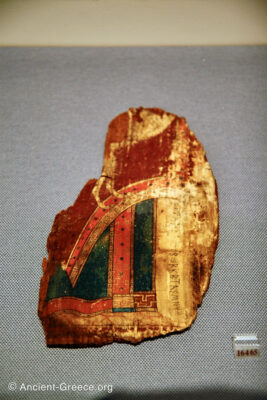One of four wooden plaques found in a cave near ancient Sikyon, in Corinthia. The inscriptions reveal that they were dedicated to the Nymphs, the local fertility deities, who were worshipped in the cave.
According to information from the museum: “Painted wooden panels were amongst the most popular forms of cheap dedications in the sanctuaries of the gods. Although they are humble small works, the Pitsa plaques are of great value as the only examples of Corinthian large-scale painting. They are executed in the xerography technique, using mineral pigments. Within the clear black or red outlines of the figures, white, red, blue, yellow, violet, brown, green and black colours were applied solid, with no gradations. The inscriptions recording dedications and names are written in the Corinthian alphabet. Procession to an altar to sacrifice a lamb, accompanied by the flute and lyre. The dedication to the Charites (Graces) can be read, along with the names Euthydika, Eukolis, Etheloncha and, at the side, the name of the painter or dedicator, of which only the place of origin survives: ‘Corinthian’. 540-530 BC.”
Exhibited at the National Archaeological Museum in Athens, Greece.
© All rights reserved 2002-2025


